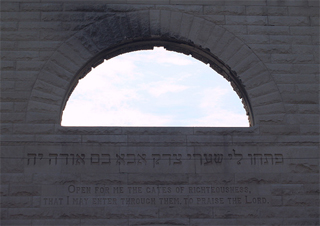Pilgrim Baptist Reboot: Second try at saving history
By JoshMogerman in News on Apr 3, 2011 7:00PM

A burned out window at Pilgrim Baptist Church shows the building's history [Righteousness by Kimball_Homan]
Originally built in 1891 to house Chicago’s oldest synagogue, K.A.M. (which moved to Kenwood long ago, where it is now situated across the street from Barack Obama’s house), the building had been cited as a text book example of the grand designs of this town’s first architectural patron saints, Dankmar Adler and Louis Sullivan. As the neighborhood changed, so did the house of worship, becoming Pilgrim Baptist Church in the 1920’s where Thomas Dorsey became the music director and was credited with creating the Gospel music genre. James Brown introduced the Blues Brothers to their “mission from God” in the sanctuary. And, the church was a footnote in the Blago ugliness leading up to the Governor being unseated (undoubtedly the least important detail of the bunch).
Given the significance of the building, it was no surprise that a quick plan was hatched to bring the church back in 2008. But delays and a whopping $37 million price tag have dogged the project. Church leaders announced a new plan yesterday that seems a lot more realistic to us. The price tag is still giant, but breaking the rehab into chunks means that we may see a restored façade, roof, and the disappearance of the massive structural beams by next Fall. Ironically, those beams are part of the impetus to get rolling as neighbors have complained the steel has become an eyesore that has robbed them of sidewalk access for years. And the new architectural vision, a return to the look of the building in the 1930’s when it was at its cultural apex, is likely to excite funders in the architectural, music, and African American history communities. We are not sure that will be enough to pay for all four phases of the now-$30 million project, but getting the exterior stabilized and cleaned up quickly is a great start, so we can hearken back to happier days: